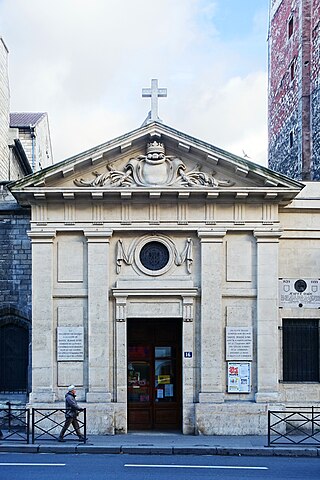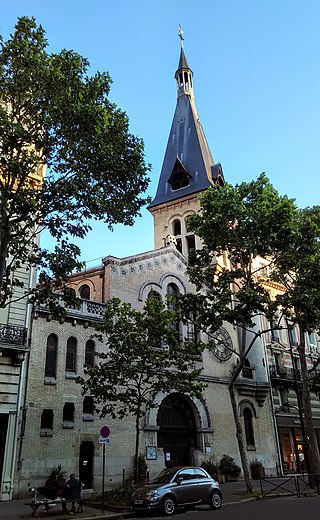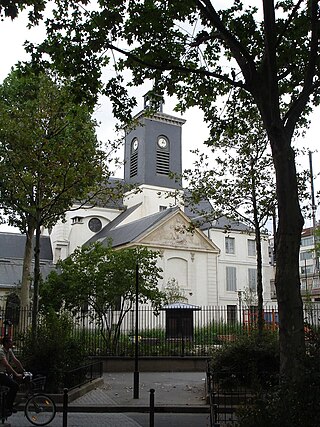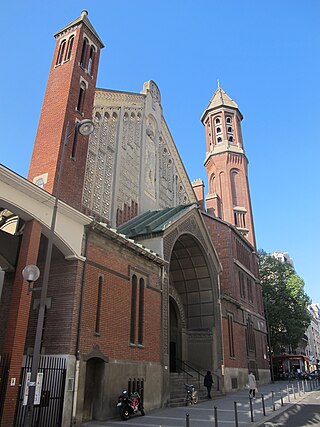
The Church of Saint-Germain-des-Prés is a Roman Catholic parish church located in the Saint-Germain-des-Prés quarter of Paris. It was originally the church of a Benedictine abbey founded in 558 by Childebert I, the son of Clovis, King of the Franks. It was destroyed by the Vikings, rebuilt, and renamed in the 8th century for Saint Germain, an early Bishop of the city. it was rebuilt with elements in the new Gothic style in the eleventh century, and was given the first flying buttresses in Paris in the 12th century. It is considered the oldest existing church in Paris.

The Church of St. Eustache, Paris, is a church in the 1st arrondissement of Paris. The present building was built between 1532 and 1632.

The Church of Saint-Germain-l'Auxerrois is a Roman Catholic church in the First Arrondissement of Paris, situated at 2 Place du Louvre, directly across from the Louvre Palace. It was named for Germanus of Auxerre, the Bishop of Auxerre (378–448), who became a papal envoy and met Saint Genevieve, the patron saint of Paris, on his journeys. Genevieve is reputed to have converted queen Clotilde and her husband, French king Clovis I to Christianity at the tomb of Saint Germain in Auxerre.

Toulouse Cathedral is a Roman Catholic church located in the city of Toulouse, France. The cathedral is a national monument, and is the seat of the Archbishop of Toulouse. It has been listed since 1862 as a monument historique by the French Ministry of Culture.

The Église de la Sainte-Trinité is a Roman Catholic church located on the place d'Estienne d'Orves, at 3 rue de la Trinité, in the 9th arrondissement of Paris. It was built between 1861 and 1867 during the reign of Emperor Napoleon III, in the residential neighborhood of the Chaussée d'Antin. It is in the ornate Neo-Renaissance or Second Empire Style, with a highly visible 65-meter-tall belfry.

The Basilica of Saint Clotilde is a basilica church located on the Rue Las Cases, in the 7th arrondissement of Paris. It was constructed between 1846 and 1856, and is the first example of a church in Paris in the neo-Gothic style.

The Église Saint-Augustin de Paris is a Roman Catholic church located at 46 boulevard Malesherbes in the 8th arrondissement of Paris. The church was built between 1860 and 1871 by the Paris city chief architect Victor Baltard. It was the first church in Paris to combine a cast-iron frame, fully visible, with stone construction. It was designed to provide a prominent landmark at the junction of two new boulevards built during Haussmann's renovation of Paris under Napoleon III. The closest métro station is Saint-Augustin

Saint-Denys de la Chapelle is a church in the 18th arrondissement of Paris. The interior dates to 1204, making it one of the oldest in Paris. The facade added in the 18th century.

The Church of Saint-Nicolas-des-Champs is a Catholic church in Paris' Third arrondissement. Early parts of the church, including the west front, built 1420–1480, are in the Flamboyant Gothic style, while later portions, including the south portal, mostly built 1576–86, are examples of French Renaissance architecture. It is notable particularly for its Renaissance carved sculpture, decoration and large collection of French Renaissance paintings in the interior.

The Church of St. John Berchmans is the Roman Catholic church of St Michael's College in the Brussels municipality of Etterbeek, Belgium. Founded by the Society of Jesus at the turn of the 20th century, the church is dedicated to the Belgian Jesuit Saint John Berchmans.

Notre-Dame des Blancs-Manteaux is a Roman Catholic parish church at 12 Rue des Blancs-Manteaux in Le Marais, in the 4th arrondissement of Paris. It takes its name from the "Les Blancs-Manteaux", for the cloaks worn by the mendicant Augustinian Order of Servites, who founded the first church 1258. It was rebuilt between 1685 and 1689 in the French Baroque or French neoclassical style. It is noted for its remarkable carved wood pulpit (1749) and its collection of paintings and sculpture.

Saint-Jacques du Haut-Pas is a Roman Catholic parish church in Paris, France. The church is located at the corner of Rue Saint-Jacques and Rue de l'Abbé de l'Épée in the 5th arrondissement of Paris. The first church on the site, a monastery chapel, was built in 1360. The present church was completed in 1685. The church is named for Saint-Jacques Du-Haut-Pas,", a cousin of Christ and the first bishop of Jerusalem, who was martyred in the year 60.It was registered as an historical monument on 4 June 1957.

Saint-Antoine des Quinze-Vingts is a Roman Catholic parish church located at 66 Avenue Ledru Rollin in the 12th arrondissement of Paris.

Notre-Dame-des-Champs is a Roman Catholic church located at 91 Boulevard du Montparnasse, at the southern edge of the 6th arrondissement of Paris. The church is named after the Blessed Virgin Mary, under the title of Our Lady of the Fields. It was completed in 1876, built using an iron framework designed by Gustave Eiffel.

Sainte-Marguerite, Paris is a Roman Catholic church located at 36 Rue Saint-Bernard in the 11th arrondissement of Paris. It was founded in 1625, and constructed in a neoclassical style. A notable feature of the interior is the Chapel of the Souls in Purgatory, a chapel created by the architect Victor Louis between 1760 and 1764, using trompe-l'oeil murals to illustrate the values of antiquity and the Counter-Reform. The church was classified as a national historic monument by the French Government in 2017.

The Church of Saint-Jean-Bosco is a Roman Catholic church located at 79 rue Alexandre-Dumas in the 20th arrondissement of Paris. Built between 1933 and 1938, it is a rare example of a Paris church in the Art Deco style. It takes its name from Saint John Bosco (1815–1880), an Italian Catholic priest who founded the order of the Salesians of Don Bosco, and devoted his career to promoting education for working-class children, both boys and girls. All of the paintings, murals, stained glass, mosaics, statues and architecture were created within a decade, giving them a harmonious Art Deco style. It was designated as a French national historic monument in 2001.

Notre-Dame-de-la-Compassion is a Roman Catholic Church located on Place du Général Koenig in the 17th arrondissement in Paris. It was originally built in 1842–43 as a memorial chapel to Ferdinand Philippe, Duke of Orléans, the heir to King Louis-Philippe of France, who was killed in a road accident in 1842. It was built in the Neo-Byzantine style, with elements of Gothic, Baroque and other styles, and was originally called the Chapelle Royale Saint-Ferdinand. In 1970 it was moved stone by stone from its original location a short distance away to make space for the new Palais des Congrès. It became a parish church in 1993. Its notable decoration includes stained glass windows designed by Jean-Auguste-Dominique Ingres, and sculpture by Henri de Triqueti. It was designated a French historic monument in 1929.

The Église Saint-Philippe-du-Roule is a Roman Catholic church located at 154 Rue du Faubourg-Saint-Honoré in the 8th arrondissement of Paris. Resembling a Roman temple. it was built in the style of Neoclassicism between 1774 and 1784 by architect Jean-François Chalgrin best known for his design of the Arc de Triomphe. It was enlarged in 1845 by the architects Étienne-Hippolyte Godde and Victor Baltard.

Saint-Christophe-de-Javel is a Roman-Catholic church located at 4 rue Saint-Christophe in the 15th arrondissement of Paris. It was constructed between 1926 and 1930 in the newly industralized neighborhood of Paris by the architect Charles-Henri Besnard (1881-1946), a follower of the architect and historian Viollet-le-Duc. While the church architecture is inspired by the Gothic architecture of the 13th century, it was constructed using a modern material, reinforced concrete, and made an innovative use of molded cement for the decoration of the facade and interior.

Notre-Dame de la Gare' is a Roman Catholic parish church located on Place Jeanne-d'Arc in the 13th arrondissement of Paris, France. It was built between 1855 and 1864 in an area of Paris which was rapidly industrializing, and was located near the major freight railway station, or "Gare", which gave the church its name. The style was inspired by Romanesque architecture.



































